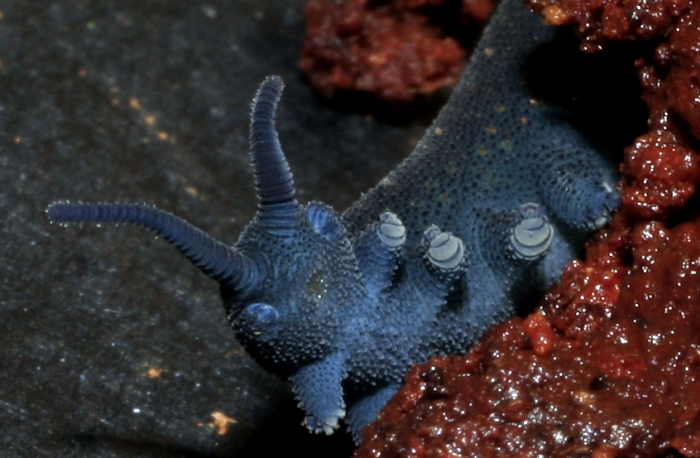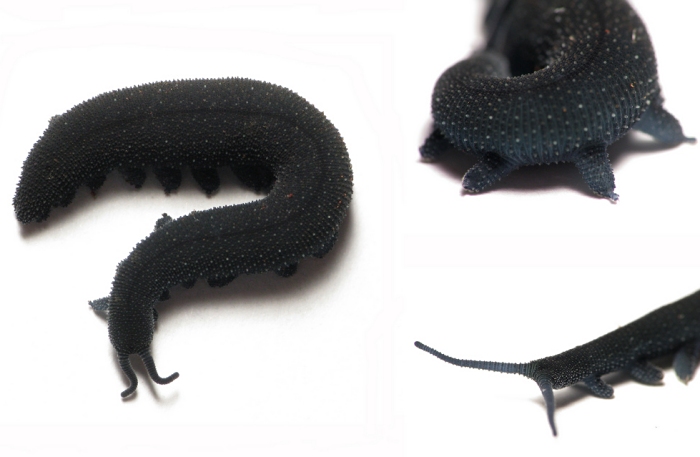| The Alien Velvet Worms |
A group more common and diverse in prehistoric seas, the Onycophorans have been considered by some to
be direct modern relatives of the Anomalocarididae, though the relationship is uncertain. Others have placed
these creatures squarely within the arthropoda and still others have planted them somewhere between the
arthropods and the annelids. Whatever the hell else you want to consider them, I just think they're really neat
and have been meaning to talk about them in painstaking detail for a considerable amount of time.
be direct modern relatives of the Anomalocarididae, though the relationship is uncertain. Others have placed
these creatures squarely within the arthropoda and still others have planted them somewhere between the
arthropods and the annelids. Whatever the hell else you want to consider them, I just think they're really neat
and have been meaning to talk about them in painstaking detail for a considerable amount of time.

Look at that little face. Today's surviving Onycophora are commonly referred to as "velvet worms" for their
fuzzy, carpetlike skin texture, actually millions of branched, warty sensory organs. Their soft, tubular bodies
definitely call to mind an earthworm, though their segments repeat almost seamlessly. Their rubbery, conical
legs are essentially fluid-filled bags, lacking any stiff joints but ending in tiny, clawed feet. The distinctively
snail-like heads are made up of three segments; the first bears a pair of sensitive tentacles, extensions of what
would be the labrum or "upper lip" of an arthropod. The second bears the tiny eyes (if any) and a sphincter-like
ring surrounding the mouth, an external extension of the throat. Hidden deep within these soft and harmless
looking lips are a set of sickle-shaped, serrated mandibles related to the same talons found on the feet, not
unlike having an extra set of toes inverted into the back of your throat. On the third and final head segment are
a pair of retractable nozzles connected to complex slime glands, the velvet worm's secret weapon.
fuzzy, carpetlike skin texture, actually millions of branched, warty sensory organs. Their soft, tubular bodies
definitely call to mind an earthworm, though their segments repeat almost seamlessly. Their rubbery, conical
legs are essentially fluid-filled bags, lacking any stiff joints but ending in tiny, clawed feet. The distinctively
snail-like heads are made up of three segments; the first bears a pair of sensitive tentacles, extensions of what
would be the labrum or "upper lip" of an arthropod. The second bears the tiny eyes (if any) and a sphincter-like
ring surrounding the mouth, an external extension of the throat. Hidden deep within these soft and harmless
looking lips are a set of sickle-shaped, serrated mandibles related to the same talons found on the feet, not
unlike having an extra set of toes inverted into the back of your throat. On the third and final head segment are
a pair of retractable nozzles connected to complex slime glands, the velvet worm's secret weapon.


Though squishy, fluffy, beady-eyed and very slow, all velvet worms are exclusively predatory, and routinely
feed upon much more active insects and arachnids. Picking up the slightest disturbances in the air on its
sensitive skin growths, a velvet worm silently sneaks up on small invertebrates and assesses their potential as
prey with gentle, cautious strokes of its tentacles. Should it find the meal suitable, it unleashes its dual slime
nozzles and assaults even a fleeing target with twin streams of quick-drying "glue," waving beautifully through
the air like...well, almost exactly like the Ghostbuster's proton streams. Poetic, I know. Essentially pinned down
by a rubber cement net, prey can only squirm helplessly in place as the velveteen devil softly pitter-patters ever
closer, flexing the chitinous knives hidden in its sock-puppet maw. A single precise bite and injection of saliva
will begin to break down the prey's innards, and feeding begins with the reingestion of the precious slime-gun
ammunition.
feed upon much more active insects and arachnids. Picking up the slightest disturbances in the air on its
sensitive skin growths, a velvet worm silently sneaks up on small invertebrates and assesses their potential as
prey with gentle, cautious strokes of its tentacles. Should it find the meal suitable, it unleashes its dual slime
nozzles and assaults even a fleeing target with twin streams of quick-drying "glue," waving beautifully through
the air like...well, almost exactly like the Ghostbuster's proton streams. Poetic, I know. Essentially pinned down
by a rubber cement net, prey can only squirm helplessly in place as the velveteen devil softly pitter-patters ever
closer, flexing the chitinous knives hidden in its sock-puppet maw. A single precise bite and injection of saliva
will begin to break down the prey's innards, and feeding begins with the reingestion of the precious slime-gun
ammunition.
Like their arthropod cousins (brothers? Grandchildren? Uncle's weird roommates?) the Onychophorans have
two distinct sexes. Females can be egg layers or live bearers, and possess a single vagina between the final
pair of legs, just like some of you!
Considerably less human are the variable reproductive methods of the males; in the species Euperipatoides
rowelli, the male secretes sperm from his genitalia but collects it into specialized facial structures before
shoving his head right inside the female's vagina. In some species of the genus Peripatopsis, a packet of
sperm is deposited onto the female's back or sides, then "attacked" by her own Amoebocytes (like our own
white blood cells) which decompose her "skin" until the sperm leaks into her body, navigates her blood stream
and enters the ovaries. One genus appears to possess an honest-to-god penis, but has yet to be observed
using it. The mating practices of most other species remain unknown, but may be connected with the strange,
bladed appendages on the heads of some males.
two distinct sexes. Females can be egg layers or live bearers, and possess a single vagina between the final
pair of legs, just like some of you!
Considerably less human are the variable reproductive methods of the males; in the species Euperipatoides
rowelli, the male secretes sperm from his genitalia but collects it into specialized facial structures before
shoving his head right inside the female's vagina. In some species of the genus Peripatopsis, a packet of
sperm is deposited onto the female's back or sides, then "attacked" by her own Amoebocytes (like our own
white blood cells) which decompose her "skin" until the sperm leaks into her body, navigates her blood stream
and enters the ovaries. One genus appears to possess an honest-to-god penis, but has yet to be observed
using it. The mating practices of most other species remain unknown, but may be connected with the strange,
bladed appendages on the heads of some males.
As foreign as these multilegged oozinators appear, many Onychophorans exhibit a social life similar to that of
many predatory mammals, forming groups of up to fifteen creepy crawlers who combine their goo guns to
lasso more (and larger) prey than they ever could as individuals. In the most studied social species, it is always
a female who reigns supreme over the "pack," eating her fill while the rest wait their turn. Other mature females
rank second to the Matriarch, mature males third, and juveniles eat last. Adults establish dominance by
measuring one another with their tentacles and climbing atop their subordinates, a process sometimes leading
to a more violent biting match. Young, not known to show such aggression, may climb upon adults but go
completely unacknowledged, perhaps practicing dominant behavior from an early age...do I dare open the can
of (anthropomorphised) worms and call that playing? I'm going to call it playing. Take that, objectivism! When
group hierarchy is complete, members will form pairs regardless of sex, though male-female pairs seem to be
formed first, female pairs second, and male pairs last. Precisely how this relates to the hierarchy isn't
completely clear.
many predatory mammals, forming groups of up to fifteen creepy crawlers who combine their goo guns to
lasso more (and larger) prey than they ever could as individuals. In the most studied social species, it is always
a female who reigns supreme over the "pack," eating her fill while the rest wait their turn. Other mature females
rank second to the Matriarch, mature males third, and juveniles eat last. Adults establish dominance by
measuring one another with their tentacles and climbing atop their subordinates, a process sometimes leading
to a more violent biting match. Young, not known to show such aggression, may climb upon adults but go
completely unacknowledged, perhaps practicing dominant behavior from an early age...do I dare open the can
of (anthropomorphised) worms and call that playing? I'm going to call it playing. Take that, objectivism! When
group hierarchy is complete, members will form pairs regardless of sex, though male-female pairs seem to be
formed first, female pairs second, and male pairs last. Precisely how this relates to the hierarchy isn't
completely clear.
